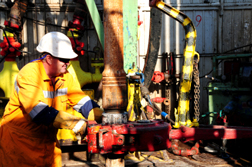 A drilling mud lawsuit, filed by a plaintiff often appearing in court accompanied by an oxygen tank, is the next logical step in pursuit of compensation.
A drilling mud lawsuit, filed by a plaintiff often appearing in court accompanied by an oxygen tank, is the next logical step in pursuit of compensation.Asbestos drilling, beyond any damage it does to the environment, has proven to be an issue for the mud engineer or any employee tasked with working in close proximity, without adequate protection, to a product that contains asbestos.
Now there appears to be emerging an issue that has an eerie parallel to the drilling mud problem noted above.
Hydraulic fracturing, or fracking - the process of extracting trapped reserves of oil and gas from underground rock by pumping in various chemicals via highly compressed air to fracture the rock and capture the booty that lay below. Much has been written about the alleged contamination of groundwater stemming from this growing practice, fallout captured as the essence of a major motion picture last year.
However, akin to oil drilling mud and the hazards posed to workers is the risk associated with exposure to dust with high levels of respirable crystalline silica.
Forbes.com (6/22/13) revealed the hazard alert issued by the Occupational Safety and Health Administration (OSHA) and the National Institute for Occupational Safety and Health (NIOSH) with regard to silica exposure. The alert was issued on the first day of summer, last year.
“Hazardous exposures to silica can and must be prevented,” said Dr. David Michaels, assistant secretary of labor for occupational safety and health, in a statement issued in tandem with the health advisory. “It is important for employers and workers to understand the hazards associated with silica exposure in hydraulic fracturing operations and how to protect workers.”
According to the report, the sand used in hydraulic fracking contains up to 99 percent silica. Breathing air laced with silica dust without adequate protection can cause silicosis, a lung disease. NIOSH collected 116 full shift air samples at 11 fracking sites in five states - Arkansas, Colorado, North Dakota, Pennsylvania and Texas.
Of the samples collected, 47 percent revealed silica exposures greater than the calculated OSHA Permissible Exposure Limit (PEL), while 79 percent showed silica exposures greater than the NIOSH Recommended Exposure Limit (REL). Some 31 percent of all samples presented silica exposures at 10 or more times the REL, with one sample clocked in at more than 100 times the REL.
And exposure to silica is not confined to fracking either. A report commissioned by the Insurance Information Institute called “Silica Liability” and released nine years ago sounded the alarm over silica exposure in various industries around the US. As for the number, NIOSH speculated at the time that as many as 1.7 million US workers could be exposed to silica.
The Forbes.com report noted that deaths from silicosis are on the decline. But that hasn’t stopped silica-related claims from rising.
There are other similarities linking asbestos drilling and fracking. Beyond the hazards to the mud engineer and any worker coming into close contact with asbestos drilling mud is the eventual whereabouts of the drilling mud once it is spent. Previous reports have revealed spent oil drilling mud is mixed with soil and trucked away for use as fill in various applications, although those applications were not identified.
According to Business Insurance (2/25/13), the potential fallout for fracking is not limited to contamination of groundwater, as it is often alleged. According to the insurance industry, environmental risks can include air pollution from methane emissions at well sites, and fumes from drilling equipment and trucks hauling fracking fluid and wastewater; together with accidental wastewater spills.
There have also been questions as to what to do with the millions of gallons of “flowback” water produced by the fracking process. Previously, according to the report, flowback has been dumped in open evaporation pits, which carries the potential for overflow or leakage. Flowback has also reportedly been injected into disposal wells which, according to the report, have been linked to earthquakes in three states.
Fracking companies are reportedly moving toward recycling of this flowback, which can contain radioactive radium and benzene. The latter can cause cancer.
All this has the insurance industry up in arms, while the legal community is poised for service if needed.
READ MORE ASBESTOS DRILLING MUD LEGAL NEWS
Accidents involving drilling mud companies result in headlines, as does the emerging fracking controversy. Less is known about the health hazards of drilling mud additives to workers, in kind with the silica hazards to fracking workers and other hazards of spent fracking flowback water beyond contamination of groundwater.
But as the process of fracking continues to expand, shepherded by oil and gas companies determined to access trapped supplies deep underground, health and insurance issues will continue to come to the fore much like they have over oil well drilling mud. Regardless of the issue, when your health is grievously compromised through no fault of your own, the legal community is a welcome resource when justice is required, and deserved.

READER COMMENTS
Greg Marsh, Exposure Scientist
on